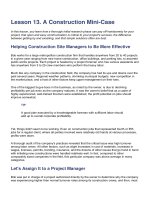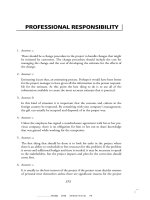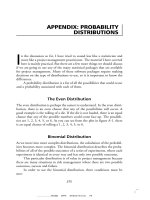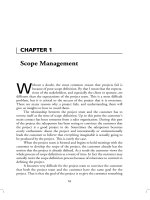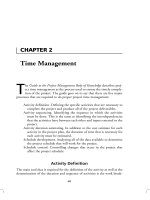Project Management Professional-Chapter 1
Bạn đang xem bản rút gọn của tài liệu. Xem và tải ngay bản đầy đủ của tài liệu tại đây (185.7 KB, 31 trang )
CHAPTER 1
Scope Management
W
ithout a doubt, the most common reason that projects fail is
because of poor scope definition. By that I mean that the expecta-
tions of the stakeholders, and especially the client or sponsor, are
different than the expectations of the project team. This is a most difficult
problem, but it is critical to the success of the project that it is overcome.
There are many reasons why a project fails, and understanding them will
give us insights to how to avoid them.
The relationship between the project team and the customer has to
reverse itself at the time of scope definition. Up to this point the customer’s
main contact has been someone from a sales organization. During this part
of the project the salesperson has been trying to convince the customer that
the project is a good project to do. Sometimes the salesperson becomes
overly enthusiastic about the project and intentionally or unintentionally
leads the customer to believe that everything imaginable is actually going to
be produced by the project. This is rarely the case.
When the project team is formed and begins to hold meetings with the
customer to develop the scope of the project, the customer already has the
notion that the project is already defined. As a result the customer views the
whole process of scope definition as a waste of time. In fact the customer may
actually resist the scope definition process because of reluctance to commit to
defining the project.
It becomes very difficult for the project team to convince the customer
that both the project team and the customer have the same goal for the
project. That is that the goal of the project is to give the customer something
16
17Scope Management
that is useful and something that does what is wanted in the first place.
There is no point in having an adversary relationship between the customer
and the project team. Both want the project to succeed, and both want the
project to be useful and serve the purpose for which it was intended.
The project team needs to understand the customer as well. The team
should not be frustrated if the customer seems to know less about the project
than the project team. After all, the reason that the project team is doing the
project is because they are expert at accomplishing the project. The customer
is not expert in doing the project. That is why the project team was formed
in the first place.
Sometimes extraordinary means must be used to develop the scope of
the project. It may be necessary for one or more project team members to
work in the customer’s area for a period of time and become trained in the
work that the project is supposed to enhance. This is a good technique when
the customer is not willing or able to cooperate in devoting the necessary
time and manpower to working with the project team. The project team
member simply becomes a surrogate customer and learns enough about the
customer’s operation to speak for the customer.
Of course it is much more desirable to have the customers themselves
play this role. The customer should be represented in the project team, as
should all of the project stakeholders. The greater the involvement and the
greater the level of communications that you have with all of the stakehold-
ers, the sounder the project will be. This will start with the definition of the
scope of the project.
Initiation of the Project
There are several ways that a project may come into existence. A project
comes into existence with the creation of the project charter. The project
charter is a formal document that brings the project into existence. The
project charter is a small document but one that is extremely important to
getting a project started in the right direction.
Project Charter
The essential components of the project charter are simple. First, it formally
authorizes the project to begin and names the project manager. This is usu-
ally done by creating some sort of account that will allow costs to be accumu-
.......................... 9618$$ $CH1 09-06-02 14:58:42 PS
18 Preparing for the Project Management Professional Certification Exam
lated for this project. It will also contain a brief business case showing the
justification for the project.
The project charter is written by the project manager, but it must be
distributed under the signature of the person who is authorized to create the
project and funding for the project. It would make no sense to have project
managers creating and authorizing their own projects. However, it is impor-
tant that the project manager actually write the project charter. This is be-
cause it is the first opportunity for the project manager to define the project
as he or she sees it.
Constraints and Assumptions
In addition to the project charter, any constraints that will limit the project
team’s choices in any of the project activities must be noted. Predetermined
or edicted project schedules, project completion dates, and project budgets
need to be reckoned with early in the project.
Assumptions must be made for the purpose of planning the project.
These will be considerations for the availability of resources, vendors, start
dates, contract signing, and others. Assumptions are not a bad thing—we
make assumptions every day. From the moment we get out of bed each
morning we assume that the electricity will work and the water will come
out of the faucets. To successfully plan a project many assumptions will be
made or the project will never get started.
Who Are Those Stakeholders?
First of all we should say that the ‘‘stakeholders’’ are all of the people that
have something to gain or lose in the project. If we consider all of the far-
reaching effects of doing almost any project, we can see that there are a lot
of stakeholders indeed. However, we are generally concerned only with the
key stakeholders of a project. We must be careful that we consider all of the
stakeholders in a project, some just to a lesser extent than others. Our main
concern is going to be the ‘‘key’’ stakeholders. The first problem is to identify
them. How can we best accomplish this task? For some reason there is reluc-
tance on the part of project managers to contact all of the key stakeholders
in the project, let alone the ones that are not so critical. This results in a
poor definition of what the project is all about. With a poor definition of
what the project is all about, there is no hope of ever being able to construct
a project plan and determine the cost, schedule, and scope objectives that
project managers hold so dear to their hearts.
One of the techniques that can be used is to have seven to ten members
.......................... 9618$$ $CH1 09-06-02 14:58:43 PS
19Scope Management
of your project team get together and use one of the group dynamics tech-
niques to come up with the names of all the stakeholders for the project.
One technique that is gaining in popularity these days is called the Crawford
slip.
Using this technique, each person in the group is given ten pieces of
paper. The facilitator asks the question, ‘‘Who is the most important stake-
holder in this project?’’ Each of the participants must answer the question
with the best answer he or she can think of. This is all done in silence, and
the answers are not discussed at this time. The facilitator waits one minute,
exactly, and asks the same question again. Each time the question is asked,
the participants must answer the question. An answer cannot be used more
than one time by each participant.
After the question has been asked ten times, the group should have
generated seventy to ninety responses. If the group has been picked carefully
so that there is diversity among the participants, there is a good chance that
a high percentage of the stakeholders have been identified.
At this point the list of stakeholders can be compiled and distributed
to the participants for additions and corrections. With this technique we
have gone a long way toward identifying the stakeholders for the project.
Cost and Its Relationship to Price
One of the things that seems to be confusing is the relationship between cost
and price. So, the first thing we should do is to make certain that we are all
using the same meanings for these two words.
Price is the amount of money (or something else) that a customer or
stakeholder is willing to give you in order to receive something from you.
Generally, in terms of project management, the thing that is being done for
the stakeholder is the project, and the things that the customer and stake-
holders receive are the deliverables of the project. These things can be either
goods or services. Money is usually the thing that is given in exchange for
doing the project. Cost, on the other hand, is the amount of resources
(money, people, materials, equipment and so on) that are consumed in order
to produce the delivered goods or services, the results of the project.
What is the relationship between cost and price? Are we satisfied if we
are able to make a reasonable profit on what we do for our stakeholders? Are
we satisfied if the cost of doing a project is less than the selling price by some
accepted percentage?
Let’s explore this a bit. Suppose we say we would be satisfied if our
total project cost was 85 percent of the selling price. We must first ask where
.......................... 9618$$ $CH1 09-06-02 14:58:43 PS
20 Preparing for the Project Management Professional Certification Exam
the selling price came from. Did our sales and marketing people try to get
the highest price they could, or were they satisfied by being able to get the
acceptable 15 percent markup from the customer?
Eliyahu Goldratt said in his book It’s Not Luck that the price of some-
thing should be determined by ‘‘the perceived value to the buyer.’’ What
this means is that the selling price of anything we do should be determined
by what the customer and the stakeholders are willing to pay. Having deter-
mined what the stakeholders are willing to pay, we then need to determine
whether it is profitable enough for us to do the work. To determine this we
must determine cost.
In order for us to stay competitive in a world of global competition it
is important that we recognize this. In the beginning of a product life cycle
or when a new service is being offered for the first time, it is important that
the stakeholders pay the price equivalent to the value of the goods or services
they receive. It is also important that the project team produce the delivera-
bles of the project for the minimum cost.
This will leave what may seem like an excessive profit. It is important
for the future of the company that these excessive profits be used to invest
in improving the company’s ability to produce future projects for less cost.
The competition will be eager to come into a highly profitable and growing
new business area. When they do, they will be willing to reduce the price to
your customers to entice them away from your organization. And when this
happens the company that started it all had better have been making cost
improvements all the while or risk the loss of a major market share.
So, a couple of things are important here. One is that we ask the cus-
tomer to pay a price that is relevant to the perceived value of what they
receive. The second is that the company providing the goods or services
takes the extra profit and invests it in its ability to reduce costs as the product
matures and competition enters the market.
Overbid or Underbid: Which Is Better for Your Company?
We said that it was important to price things according to the perceived
value to the customer. In other words, if a project has a high value to stake-
holders and customers, they should pay a price that is high as well.
Now, suppose we are in a bidding situation. Our organization is in the
kind of business where the stakeholders publish requirements and companies
like ours submit a firm fixed price to do the work specified. Many construc-
tion projects work this way, but other types of projects are done this way,
too. A number of companies are bidding for the same project.
.......................... 9618$$ $CH1 09-06-02 14:58:44 PS
21Scope Management
The question is then: Is it better for companies to underbid or overbid
projects like this? Most people would say, ‘‘It is better to overbid the project
because if I underbid I may win the project but lose money trying to com-
plete it.’’ Let us explore this issue.
A company that underbids a project and wins the bid finds that the
cost estimate for doing the work was too low and as a result they did not
charge enough to the stakeholder to make a profit. In fact the company
may actually lose money on this project. This gives the company immediate
feedback; they know soon after starting the work that there will not be
enough money coming from the customer to pay all the costs and expenses
associated with the project. At this point lots of unhappy things take place.
The company may go to the customer or stakeholders and ask for addi-
tional funds. The company may have to grin and bear it and lose money or
at least not make as much money as they would like. The company may try
to reduce the requirements to save cost, with or without the customer’s
approval. Panic may follow, leading to a very unhappy situation all around.
But, every cloud has a silver lining. The company in this situation at
least knows where it stands, and one way or another, the next time the
company bids on a job it will increase the price. Companies in this situation
either learn from this experience or they soon find another line of work.
Remember the other situation we talked about—the company overbids
the work. In this situation, only two things can happen. The company bids
too high and does not get the work, or the company bids high and gets the
work anyway.
In the first situation, the company loses the bid and does not get to
work on the project. This may or may not have a positive effect on future
business. If the company was convinced that the bid they submitted was just
too high, they might look into their cost estimating process or some of the
costs associated with the way they are doing things. Many times companies
don’t do this. They are convinced that for some unknown reason the compe-
tition got the job and they did not. You will hear about how so-and-so’s
brother-in-law was a friend of the purchasing agent or so-and-so’s wife is in
a bridge club with the company’s owner, and so on. Companies are reluctant
to admit that they may be doing something wrong, and they wait for the
next opportunity to come along.
Now let’s consider the situation where the company overbids the proj-
ect and is awarded the contract anyway. This could actually be the worst
thing for the company. In the other situations we discussed there was some
feedback to the company that something was wrong, and there was some
.......................... 9618$$ $CH1 09-06-02 14:58:44 PS
22 Preparing for the Project Management Professional Certification Exam
force present to indicate that they should do business differently in the fu-
ture.
When a company overbids a project and is awarded the contract, what
budget will the company assign to the project manager of this project? They
will probably take the bid price, reduce it by some acceptable level of profit,
and ask the project manager to complete the project with those funds.
This sounds right except that, in this situation, the company overbid
the project. As a result, the company is going to overbudget the project. The
reason is that they don’t really know that they had overbid the project in the
first place.
The project manager will measure the progress and the performance of
the project according to the allocated budget. As long as the project is com-
pleted on time and underbudget and the requirements are all satisfied, no
one is likely to complain about the project performance. As time goes by,
more jobs like this are bid and won, and the company continues on with
an acceptable profit. Their projects are completed, and everyone is happy.
Ignorance is bliss.
However, sooner or later a competitor is going to figure out that there
is extra profit to be made in this type of business. The competitor discovers
this by doing a better cost analysis than our company and starts to bid the
same jobs but at a lower price.
At first, there is no reaction. Lost work is considered just part of the
normal business cycle. As time goes by and there is less and less business, the
company may eventually come to their senses, realize that their costs are too
high, and take some corrective action.
This is very hard for companies to do. They are in the situation where
for years they have doing things the way they have and been successful. Now
they are losing business, and they have a lot of trouble figuring out why. If
they had had good cost estimates they still might have been able to overbid
the projects, but the budget for the projects would have been based on more
accurate cost estimates, and the profits would have been larger. What must
happen next is that the company must take those excess profits and invest
them in the company and modernize before being forced to by their compe-
tition.
We can see that the worst thing that could happen to a company is that
they overestimate costs. From that, they overbid work, overbudget projects,
and learn inefficient ways to do things. From all of that, they may go out of
business.
.......................... 9618$$ $CH1 09-06-02 14:58:44 PS
TEAMFLY
Team-Fly
®
23Scope Management
Getting to the Scope Baseline
The first thing that happens in a project is usually characterized by the
feeling of wild and unbridled enthusiasm. This results in a great many things
being included as the needs of the project. In many respects this is a good
thing. If the project has many good things that can result, it is probably a
good project to do. The problem is that many of these things are not neces-
sary or are impractical. Many of the items may just not be the things that
the stakeholder needs or really wants.
The next step is to have the project team and the stakeholders come
together and separate out the needs that everyone agrees are not going to be
practical or necessary for the project to be useful. When we reduce the needs
of the project by deleting the ones that everyone agrees are not part of the
project, the result is a list of the ‘‘requirements.’’
We are not nearly finished at this point. We have only reduced the
project by the items that everyone agrees to eliminate. We will need to fur-
ther reduce these items by the items that may not be good for the project.
These items are not so obvious and will not have the agreement of all the
stakeholders. There will have to be some investigation and some justification
applied to make these items acceptable or not acceptable to the project.
When this analysis is completed the result is the project’s scope baseline.
This is the first baseline that we will develop. We need to have the scope
baseline before the remaining two baselines, cost and schedule, can be com-
pleted.
When moving from requirements to scope baseline, the items that are
eliminated from the project must be documented as exclusions to the proj-
ect. It is important to do this since, at one time, these items were thought to
be good for the project by at least some of the stakeholders. If their exclusion
is not properly documented, they will return again and again as new require-
ments to be considered.
In all of these items that will or will not be included in the project there
are a number of factors that must be considered, such as cost, expense, time
to develop, service, and maintenance.
It is critically important that all of the stakeholders be involved with
the parts of the project that they have a stake in. To accomplish this there
must be a good cooperative relationship between the stakeholders and the
project team. Detailed descriptions of the intentions of the project must be
obtained.
All items making it to the scope baseline must be fully documented
.......................... 9618$$ $CH1 09-06-02 14:58:45 PS
24 Preparing for the Project Management Professional Certification Exam
and clearly defined. There must be measurable tangible results that will be
achieved. These should be documented along with the acceptance criteria as
part of the scope definition. When this is not done, scope cannot be con-
trolled, and project scope tends to creep ever upward with requests from the
stakeholders that start out by saying, ‘‘There is one little change that we
need to make to the project . . .’’ or, ‘‘This item should have been included
in the original scope of the project.’’
When all of this is completed, we will have developed a set of delivera-
bles that the stakeholders and the project team can agree upon. These deliv-
erables must be formally agreed to by all stakeholders, and there should be a
formal sign off. Everything should be done to impress all of the participants
in the project that the deliverables list is a conclusive, exhaustive list of the
things that the project is going to produce. There should be no doubt in
anyone’s mind that the deliverables list that has been agreed to is final unless
a formal change is approved. They must also know that any approved
changes to the project after this point are going to result in increases in cost.
To make all this possible, each of the project deliverables must be clear
and concise. Each deliverable must have tangible, measurable criteria that
determine that the deliverable has been completed and accepted by the stake-
holder. Every effort must be made to avoid describing deliverables in a way
that can be misunderstood. The situation where the project team thinks they
have completed a deliverable and the customer disagrees must be avoided.
For example, a project team determines that a user manual for the
system they are proposing will be required. The deliverable that they put
into the scope of the project is entered as ‘‘User Manual,’’ with no additional
description. The customer sees this and agrees to the item.
When the user manual is delivered to the customer, it is a five-page
document that basically says to hit the green button to start and hit the red
button to stop. The project team does not want to give too much informa-
tion to the customer, because they want their own maintenance and support
people to take care of problems that might arise in the life of the product
they are delivering.
On the other hand the customer’s expectations were for a fully detailed
user manual that would allow them to understand the inner workings of the
product delivered—two or three hundred pages of detailed information
about the product and its use. Stakeholders want this information because
they do not want to be committed to the supplying company forever. They
are concerned that they may have to maintain the product after they have
.......................... 9618$$ $CH1 09-06-02 14:58:46 PS
25Scope Management
terminated their relationship with the supplying company. They are also
concerned that the supplying company may go out of business.
When this dilemma becomes known, usually late in the project when
there are many things to be done, the project team says that they have met
the agreed-upon requirement with their five-page user’s manual, and the
stakeholders disagree. Generally, at this point, the stakeholders appeal to
higher levels of management in the project team’s company, and eventually
the project team will write a three-hundred-page manual.
At this point in the development of the project scope we have deter-
mined what all of the project deliverables are, and we have gotten full agree-
ment from all of the stakeholders. All of the deliverables are tangible and
measurable items that cannot be easily misunderstood. There has been a
formal sign off on the deliverables that are due to each stakeholder.
Work Breakdown Structure
At this point in our project development we have determined the delivera-
bles that are due to all the stakeholders. But we cannot plan the project
from this list of deliverables. To plan the project we must convert these into
individual pieces of work that must be done to complete the project. For
this we need the ‘‘work breakdown structure,’’ or WBS.
The work breakdown structure is the most central item in the project
plan. Without it we do not have a definition of the work that has to be done
to complete the project. Without knowing the work that has to be done we
cannot possibly determine the cost of the project or determine the schedule
of the project.
Without knowing the cost or schedule of the project how will it be
possible to control the project or determine how much should be spent to
complete it? The amount of resources that must be used on the project and
when they must be made available cannot be determined without knowing
the schedule. Funding to do the project cannot be scheduled to be in place
when the project needs it without a time-phased budget for the project.
Without knowing the work to be performed on the project, risk manage-
ment cannot be done in a satisfactory way. These things cannot be done
without the work breakdown structure.
According to the Guide to the PMBOK, the definition of a work break-
down structure is: ‘‘A deliverable oriented grouping of project components
that organizes and defines the total scope of the project work. Work outside
.......................... 9618$$ $CH1 09-06-02 14:58:46 PS
26 Preparing for the Project Management Professional Certification Exam
the WBS is outside the scope of the project.’’ In this definition of the WBS,
we are striving for a method to identify the work that is required to produce
all of the deliverables of the project. As we will see, with many projects, it
will be possible to identify close to 95 percent of the work that must be done
in the project.
To create a WBS is a simple task: the project is first broken down into
a group of subprojects. Each of these subprojects can be broken down to
sub-subprojects. The sub-subprojects can be broken down again and again
until the desired level of detail is reached. The level of detail is termed the
‘‘work package’’ level. The work package is the lowest level of management
that the project manager needs to manage. Below the work package other
project team members may break down their parts of the project into addi-
tional levels.
The reason this technique is so effective is that it follows the principle
of ‘‘divide and conquer.’’ If we were to hold a meeting and write down a list
of all the things that had to be done to complete the project, the meeting
would not produce a very good list. In a meeting of this type where there is
little focus, attention will drift into one area and do a pretty good job of
listing the work needed in that area and ignore other areas of the project.
A better way to do this is to break the project into smaller projects
or products of the project. This allows project management to become a
methodology that will work well on the largest of projects or programs as
well as the smallest. At the top levels of the a project, particularly large
projects, think of these early levels of breakdown as product breakdowns.
This is because on larger projects there can be a grouping of deliverables into
large deliverables that might be called products.
So, initially the project is broken up into a group of subprojects. These
subprojects are further broken down into sub-subprojects, and so on. In this
way the largest project we can imagine could be broken down into subpro-
jects. Since each of these subprojects could be considered to be a project in
its own right, any large project can be thought of as a family of smaller
projects that are interrelated.
A project can also be thought of as a microcosm or a macrocosm. At
any level in the breakdown structure, from the standpoint of the manager in
charge of a particular part of the project, there is a separate project that he
or she is responsible for. All projects are part of some larger project, and all
projects have subprojects within them. It is just a matter of perspective.
For example, in the 1960s the United States took on the challenge of
getting a man to the moon and safely back to Earth. The resulting project
.......................... 9618$$ $CH1 09-06-02 14:58:47 PS
27Scope Management
was very large, employing many thousands of people. The project manager
was a person who lived in Washington, D.C., and who spent most of his
time dealing with Congress and other parts of the government.
When the Apollo Program was in full swing in the 1960s, it was a very
large project indeed. There were perhaps forty thousand people working on
it at any given time. There was a project to develop the engines for the
Saturn V booster, the first stage of the launch vehicle. This project had a
project manager and many people involved. The engine development project
had several locations and several hundred people working on it. Within this
project there were other projects, such as engine testing, fuel systems, fuel
delivery, cooling, and so on.
Although the engine development project for the Apollo program was
a large effort, it was only a small part of the program. Depending on where
you were in the hierarchy of the program you might consider yourself as a
program manager, a project manager, or even a subproject manager.
As a matter of practicality, it does not make sense for the top-level
program manager or project manager to manage all of the details of the
project. In fact it is not necessary for him or her to even know about them.
So, we can see that extremely large projects result in smaller projects or
subprojects. The subprojects are themselves projects in their own right and
have their own work breakdown structures. Each project may be part of
some bigger project or macrocosm, and each project may have smaller proj-
ects, or microcosms, within it.
The important thing about project management is that it is a powerful
methodology that adapts to any size project or program. The tools and meth-
odology that are used are similar in all projects. The WBS is the tool that
allows all projects to be broken down into smaller, more manageable proj-
ects.
The end result of the WBS is a group of individual pieces of work
defined. Each of these small individual pieces of work must be assigned to
one person on the project team. The primary purpose of the WBS is to
divide the project into subprojects until a point is reached where this assign-
ment of the individual pieces of work can be made.
For a large project the WBS might stop at a rather high level. This may
be the level of control for the project manager. As mentioned earlier, this
level of the WBS is generally called the work package. It must be understood
that at this high level other project managers will take the lowest level of the
initial breakdown and further break it down until the individual piece of
work is reached.
.......................... 9618$$ $CH1 09-06-02 14:58:47 PS


